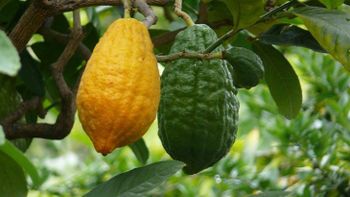Citron
Other names : Citrus medica, Cédrat, Citronnier des juifs, Zedrate, Zedrat-Zitrone, Zitronat-Zitrone, Judenapfel, Cedro, Cedrato, Cidra, Cidro, Cidrero, Poncil, Sukaattisitruuna, Suckatcitron, Sötcitron, Cedratträd, etrog.
See also :
The citron is a fragrant citrus fruit, botanically classified as Citrus medica. A citron has similarly with lemon and is a fragrant citrus fruit. It consists of a dry pulp and only a small quantity of insipid juice. So unlike lemons, the citron is prized for its outermost yellow rind. Unfortunately, in local grocery shops, you would most likely find lemons but not citrons. Although originally grown in Europe, Southern Italy is quite known for citron candies and many citron products. The one thing that would probably differentiate a citron from lemons is its shape. Citrons have a variety of shapes, and there are many factors that contribute to its highly variable shape. In fact, you would be able to find a fingered citron, having a shape that is quite interesting.
Special Precautions of Citron
Benefits and uses of Citron are
Based from ancient studies, the citron was used mainly for medicinal purposes. It was greatly used to fight seasickness, intestinal problems, pulmonary illnesses, and many more. The oil that is taken from the pulp, or the outermost layer of the rind, is actually used as antibiotic.
- In Ayurvedic system of medicine, the fruit juice is used for treating conditions like nausea, vomiting, excessive thirst etc.
- The fruit juice has a high content of Vitamin C and used medicinally as an anthelminthic, appetizer, tonic, in cough, rheumatism, vomiting, flatulence, haemorrhoids, skin diseases and weak eye sight.
